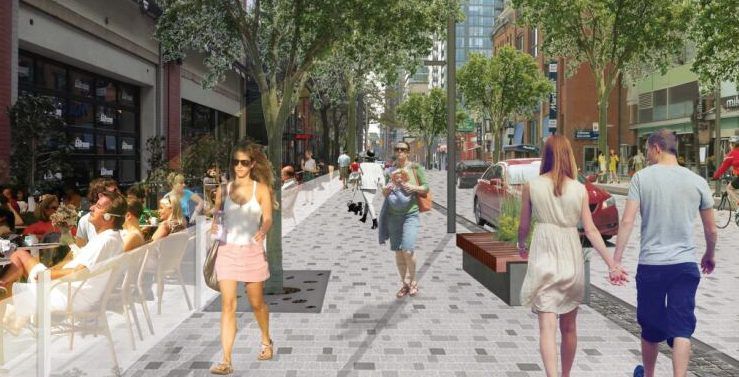
Feature Image: A rendering of 212 King Street West for the Toronto Downtown West BIA’s Growth & Development Framework – Courtesy of Dream Office Reit, Humbold Properties, Norm Li
In case you missed it, we just launched our new ArtWalk experience – a captivating audio and augmented reality tour spotlighting over 70 pieces of outdoor public art. Designed in partnership with Exar Studios with funding by the Government of Canada through the Federal Economic Development Agency for Southern Ontario, ArtWalk demonstrates the Toronto Downtown West BIA’s commitment to supporting arts and culture. If you’re curious about ArtWalk and our vibrant arts community, be sure to visit YourExperienceAwaits.ca/arts.
ArtWalk serves as a compelling example of what community placemaking can be. Art goes beyond visual appeal; it serves as a catalyst for dialogue, community engagement and social change. By weaving art into our urban fabric, we’re enriching the cultural landscape and bring people together through a shared narrative. This is the power of placemaking in forging distinctive identities for neighbourhoods and cities alike.

An image of the new augmented-reality experience at The Poet, The Fever Shed Hospital sculpture for the Toronto Downtown West BIA’s ArtWalk Experience launch.
Placemaking involves a collaborative and multifaceted approach that taps into the collective emotional connection that community members share with their surroundings. Through well-planned public spaces and initiatives, a community can evolve from being merely a geographical location into a hub of cultural vibrancy and social interconnectedness. The BIA has been instrumental in shaping downtown Toronto through various placemaking initiatives, which can serve as a guide for those seeking to shape their own communities.
A Blueprint for Community Building
A well-coordinated and unified vision for the enhancing public spaces can enrich the sense of place. This entails active community engagement, allowing local businesses, residents and stakeholders to contribute their ideas and fostering a shared sense of ownership.
Take for example, the BIA’s Growth & Development Framework. This comprehensive plan was created in response to the rapid development in our community over the past decade and focuses on three key areas – pedestrian realm network and park space system, streetscapes, and uses at grade. The Growth and Development Framework offers a visionary roadmap for communities by outlining investment priorities investment and enhancements. The framework serves as a strategic plan for a harmonious, appealing, and functional urban landscape, enabling developers and municipal government to focus their investments in a way that adds value to the community.
Master plans such as this allow for adaptability to changing needs and circumstances while preserving the place’s core identity. Additionally, they help to attract suitable businesses and investments, boosting the area’s economic vitality. At the same time, they address safety and accessibility, making spaces more welcoming and user-friendly. Ultimately, a master plan helps define the unique character and identity of a place, incorporating elements that reflect the history, culture, and values of the community.
A Cultural Hub at the Centre of it all

A rendering of the future John Street Cultural Corridor, a project funded by the Toronto Downtown West BIA in partnership with the City of Toronto.
Prominent streets play an integral role in the art of placemaking, serving as epicentres. These thoroughfares double as community gathering spaces, fostering togetherness and featuring pedestrian-centric designs that encourage exploration and engagement. Often holding historical or cultural significance, they contribute to a community’s identity while ensuring inclusivity and community involvement. Successful placemaking on these streets can boost property values and local economies, shaping the very essence of a neighbourhood or city.
One of the BIA’s most impactful endeavours (still in its planning stage) are the John Street Corridor Improvements. This project will transform the street into a cultural corridor and aims to create a pedestrian-oriented and visually engaging environment. Given John Street’s importance in connecting many of Toronto’s cultural institutions to the waterfront, this revamp is more than just a facelift—it’s a transformation that will create a destination for the area. John Street features an array of cultural institutions, theaters, galleries, and public spaces. Some notable institutions and venues connected to this corridor include the Art Gallery of Ontario (AGO), Toronto International Film Festival (TIFF), Princess of Wales Theatre, CN Tower, Canadian Broadcasting Corporation (CBC), and Rogers Centre, among others. These renowned venues provides instill a shared sense of belonging and pride within the community.
With plans to widen sidewalks, add greenery, incorporate public art, and much more, John Street will serve as a robust example of how planning and design can lead to spaces that are beautiful, accessible, and community-centric. These enhancements will create an environment that fosters a deeper connection between individuals and their surroundings, reinforcing the concept of placemaking through user-friendly and inviting aesthetics.
Connecting the Cultural Dots


Photos of the Waterfront ReConnect projects under the Gardiner Expressway. Project funding provided by the Toronto Downtown West BIA in partnership with The Bentway and Waterfront BIA.
Points of connection with nearby communities can bridge neighbourhoods, showcasing the diversity of our city. This is achievable through shared resources, providing access to a wider range of opportunities.
The BIA’s partnership with The Bentway and Waterfront BIA on the Waterfront ReConnect project illustrates the transformative potential of shared placemaking. By turning underutilized areas under the Gardiner Expressway into vibrant links between communities, this initiative proves how creativity can be used to fill gaps in our public realm. This initiative serves as a gateway to the waterfront, offering communities a fresh perspective on their surroundings.
The work of the BIA reflects the ethos of community placemaking. These aren’t merely projects; they represent experiences that engage, connect, and, at times, challenge communities to rethink and interact differently. Placemaking is not just about filling spaces; it’s about meeting the emotional, cultural, and social needs of those who inhabit these spaces. In a world where the concept of ‘community’ sometimes feels abstract, placemaking grounds us in the reality that we are all part of something grander than ourselves.
